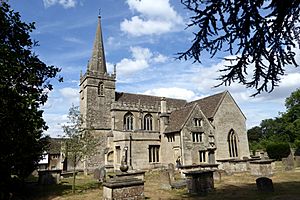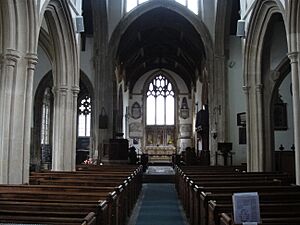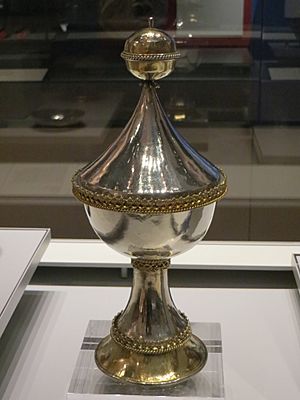St Cyriac's Church, Lacock facts for kids
St Cyriac's Church is a very old church in the village of Lacock, Wiltshire. It was built in the 14th century, which means it's over 600 years old! It belongs to the Church of England.
Contents
The Church's Long History
How St Cyriac's Church Began
The church you see today might have been built on the spot of an even older Saxon church. The first part of the current church was built in the Norman style. This means it was built by people from Normandy, France, who came to England a long time ago.
Two important landowners, Edward of Salisbury and William II, Count of Eu, helped pay for it. The church is named after a Norman saint called St. Cyriac. Inside the church, you can find many old memorials for important families who lived in the area, like the Baynards and Bonhams.
Building and Changing Over Time
The church was partly rebuilt in the 14th century. You can still see some of the beautiful "decorated" window designs from that time. Lacock was a busy market town back then. It was on a route where sheep were moved from Bath to London. Because of this, the town had a lot of money from taxes.
This money helped pay for a bigger rebuild in the 15th century. This is when the church got its "perpendicular" style, which is a type of Gothic architecture with tall, straight lines. It was built in a cross shape, which is a common design for churches. A special chapel was also added, paid for by the Bonham and Croke families.
In 1604, the church's tower was rebuilt. Later, a two-story building called the "cottage" or south annex was added. After he passed away in 1636, special brass plaques were placed on the church floor to remember Sir Robert Baynard. These plaques were stolen in 2004 but were quickly found and returned! The main part of the church, called the chancel, was rebuilt in 1777.
Restorations and Modern Touches
In the late 1800s, the Baynard family, who owned Lackham House, completely rebuilt their family chapel inside the church. They also put a new roof on part of the church and added pews for their family and workers.
In 1861, the Baynard family again helped pay for more changes. A.W. Blomfield led this work. They raised the roofs, added a new front, and removed some old wooden pews and galleries. In 1902, Sir Harold Brakspear updated the church. He made sure the changes fit well with the church's history and honored his friend, the famous photography pioneer William Henry Fox Talbot.
In 1960, St Cyriac's Church was given a special "Grade I listed" status. This means it's considered a very important historic building.
St Cyriac's Church Today
In the early 2000s, the church had many improvements. These projects were paid for by donations from people, private groups, and national organizations. The Friends of Lacock Church and the Lacock Parochial Church Council (LPCC) helped organize these efforts. For example, the main roof and part of the south transept were re-roofed in 2006.
The Famous Lacock Cup
For many years, St Cyriac's Church was home to a very special silver cup called the Lacock Cup. This cup was made in the mid-15th century and is considered one of the most important pieces of old English silver that was not used for religious purposes.
In 1962, the church lent the cup to the British Museum so more people could see it. In 2009, the cup was valued at £1.8 million. After getting permission in December 2012, the church sold the cup. It was bought together by the British Museum and the Wiltshire Museum in Devizes.
The money from the sale is being used to help fix and improve St Cyriac's Church. As part of the sale, two copies of the cup were made. One copy is used for church services at St Cyriac's. The other copy is shown at the Wiltshire Museum when the original cup is not there.




